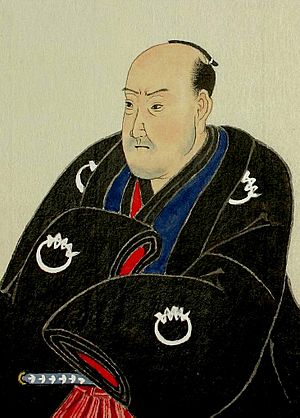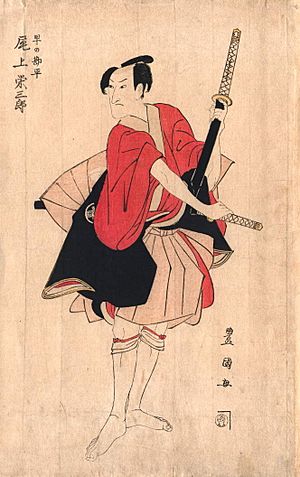Utagawa Toyokuni facts for kids

Utagawa Toyokuni (born 1769 in Edo, Japan – died February 24, 1825, in Edo), also known as Toyokuni I, was a very important Japanese artist. He was a master of ukiyo-e, which are special Japanese woodblock prints and paintings. Toyokuni was especially famous for his prints of kabuki actors.
He was the second leader of the famous Utagawa school of Japanese woodblock artists. Toyokuni helped this school become very well-known and powerful throughout the 1800s.
Contents
Meet Toyokuni: His Life Story
Toyokuni was born in Edo, which is now Tokyo. His father, Kurahashi Gorobei, made dolls and puppets, including ones that looked like kabuki actors. When Toyokuni was about 14, he became an apprentice to Utagawa Toyoharu. Toyoharu was the first head of the Utagawa school.
Toyoharu was a friend of Toyokuni's father and lived nearby. One of Toyoharu's other students was Toyohiro, who later taught the famous landscape artist Hiroshige. Toyokuni later took the name Utagawa Toyokuni. This was a common practice where students used part of their master's name to show respect.
Toyokuni wasn't someone who just created new styles out of nowhere. Instead, he carefully studied the artists who came before him. He learned a lot from artists like Kitagawa Utamaro and Chōbunsai Eishi. Through hard work, he mastered their styles and then combined them to create his own unique look.
He was most famous for his prints related to the kabuki theater. His yakusha-e (actor portraits) were especially popular. He made these prints better than ever before. Toyokuni also created other types of art, such as musha-e (warrior prints) and bijin-ga (prints of beautiful women).
In his actor prints, Toyokuni showed the actors exactly as they appeared on stage. Unlike Sharaku, who sometimes exaggerated features, Toyokuni's prints aimed to be very realistic. People said his prints made you feel like you were watching a live kabuki show. This made his prints much more popular with theater fans than Sharaku's.
Toyokuni's huge popularity and many artworks might have caused some problems later on. From 1803 to 1817, his art became less lively, even though it was still very popular. He kept making many prints, but their quality often wasn't as good as his earlier works. However, some prints from this time still showed his amazing talent.
He passed away in Edo in 1825 when he was 57 years old. Many of his students were with him at the time.
What's in a Name? Toyokuni's Many Titles
Like many Japanese artists from the Edo period, Toyokuni used several names during his life.
- Family name: Kurahashi
- Childhood name: Kumakichi
- Nickname: Kumaemon
- Art names (gō): Utagawa Toyokuni, Utagawa Ichiyōsai, Ichiyōsai Toyokuni
- Posthumous Buddhist name: Tokumyōin Jissaireigō Shinji
Today, his name "Toyokuni" is almost always written using the Japanese characters 豊国.
His Students and the Utagawa School
Toyokuni's two most important students were the famous woodblock print masters Kunisada and Utagawa Kuniyoshi. But he had many other students in his school. The Utagawa school became so powerful after Toyokuni's time that almost every important Japanese print artist either had "Kuni" in their art name or was a student of someone who did.
After Toyokuni died, his son-in-law, Toyoshige, started using his art name, "Toyokuni." That's why Toyoshige is known as Toyokuni II. Later, the name was passed down to each new leader of the Utagawa school. For example, Kunisada is also known as Toyokuni III.
Toyokuni's Artistic Legacy
People have different opinions about Toyokuni as an artist. He once said: "My pictures – they are merely something that I draw, and nothing more than that!"
Some critics say his style was often "imitative" (meaning he copied others a lot). They also point out the "marked decline" in the quality of his later works. However, many admire Toyokuni's style for its "bold, taut designs" and "decorative bombast."
He is also praised for creating new formats, like prints made of two, three, or even more panels joined together. He also trained many future masters of ukiyo-e art. His work captured the world around him, especially the kabuki theater, with great detail. His style was a step forward for art. Also, his art sold very well, which helped free woodblock prints from old rules that had limited artists before him.
Famous Art Series
Here are a few of his well-known print series:
- Views of Actors on Stage (around 1793)
- Sketches of Seven Elegant Paragons of Beauty (around 1800)
- Views of Elegant Geisha in Characteristic Poses (around 1801)
- Tomimoto the Geisha (around 1830-1844)
Where to See His Art
Images for kids
See also
 In Spanish: Utagawa Toyokuni para niños
In Spanish: Utagawa Toyokuni para niños






